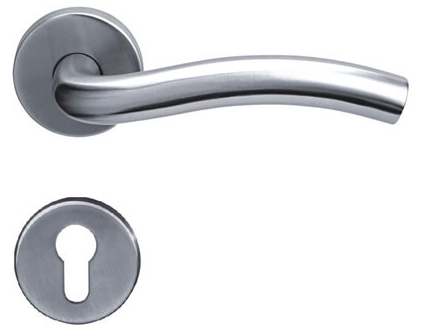Several factors causing rust on stainless steel bathroom door handles
Why does stainless steel also rust?
When brown rust spots (spots) appear on the surface of stainless steel pipes, people are greatly surprised: they believe that "stainless steel does not rust, rust is not stainless steel, it may be a problem with the steel quality.". In fact, this is a one-sided misconception about a lack of understanding of stainless steel. Stainless steel can also rust under certain conditions
Stainless steel has the ability to resist atmospheric oxidation - that is, rust resistance - and also has the ability to corrode in media containing acid, alkali, and salt - that is, corrosion resistance. But its ability to resist corrosion varies with the chemical composition, additive state, operating conditions, and type of environmental medium of the steel itself. For example, 304 steel pipes have excellent rust resistance in a dry and clean atmosphere, but when moved to coastal areas, they will quickly rust in sea mist containing a large amount of salt; And 316 steel pipe performs well. Therefore, not any type of stainless steel can withstand corrosion and rust in any environment.
Stainless steel is a thin and stable chromium rich oxide film (protective film) formed by its outer surface, which prevents the continuous entry and oxidation of oxygen atoms, thus obtaining the ability to resist corrosion. Once for some reason, this thin film is constantly damaged, oxygen atoms in the air or liquid will continuously enter or iron atoms in the metal will continuously separate, forming loose iron oxide, and the metal surface will also be constantly corroded. This kind of outer film is damaged

There are many forms of bad behavior, and the following are common in daily life:
1. The surface of stainless steel contains dust containing other metal elements or attachments of dissimilar metal particles. In humid air, the attachment and the condensate between the attachment and stainless steel form a micro battery, triggering an electrochemical reaction and damaging the protective film, which is called electrochemical corrosion.
2. Adhesives and juices on the surface of stainless steel (such as melons, vegetables, noodle soup, phlegm, etc.) can form acid in the presence of water and oxygen, which can corrode the metal surface over time.
3. The surface of stainless steel adheres to substances containing acids, alkalis, and salts (such as alkaline water and lime water splashing on decorative walls), causing local corrosion.
4. In polluted air (such as atmospheres containing large amounts of sulfides, carbon oxides, and nitrogen oxides), when encountering condensed water, it forms sulfuric acid, nitric acid, and acetic acid liquid points, causing chemical corrosion.
The above situations can cause damage to the protective film on the surface of stainless steel, leading to corrosion. So, to ensure that the metal surface is long-lasting and not corroded, we suggest:
It is necessary to regularly clean and wipe the surface of decorative stainless steel to remove attachments and eliminate external factors that may cause polishing.
2. The coastal area should use 316 stainless steel, which can resist seawater corrosion.
3. Some stainless steel pipes in the market do not meet the corresponding national standards for chemical composition and cannot meet the requirements of 304 raw materials. Therefore, it can also cause rusting, which requires users to carefully select products from reputable manufacturers.
The article originates from a manufacturer of bathroom door handles http://www.jmjchwj.com
-
04-25
Stainless steel handle manufacturer: How to deal with dirty hotel handles?
Cleaning and protection(1) When cleaning the exterior of the decoration pipe, gently wipe it with a damp cloth, and be careful not to use too much force to avoid scratching the exterior of the decorat
-
04-13
Bathroom door handle manufacturer: General decorative hardware accessories
Universal decoration hardware accessories refer to machine parts or components made of hardware, as well as some small hardware products. It can be used alone or as a helper. For example, hardware too
-
12-02
Maintenance of stainless steel handles
Maintenance of stainless steel handlesThere are various styles of interior design nowadays, but stainless steel handles are mostly prioritized in the selection of handles. Due to its elegant appearanc
-
11-09
Stainless steel handle manufacturer: What are the issues to pay attention to when choosing a door handle?
What are the issues to pay attention to when choosing a door handle?Due to the general lack of national standards for door handles, most consumers have little knowledge about the quality of door handl

